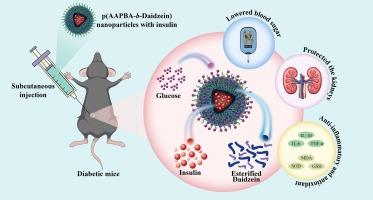Preparation and biological evaluation of a glucose-responsive block copolymer nanoparticle with the ability to ameliorate diabetic kidney damage
IF 5.8
2区 化学
Q1 POLYMER SCIENCE
引用次数: 0
Abstract
In this study, a p(AAPBA-b-Daidzein) block copolymer was designed and synthesised using glucose-responsive 3-acrylamidophenylboronic acid (AAPBA) and esterified daidzein as structural units; this copolymer possessed anti-diabetic pharmacological activity. After confirming the chemical structure of the copolymer, nanoparticles of the copolymer were prepared using the water-in-oil method. The results of the in vitro experiments showed that nanoparticles swelled when the pH was >7 or when the glucose concentration exceeded 1.0 mg/mL. Particle size measurements showed that the size of the nanoparticles was kept in the range of 100–300 nm before and after the glucose response, which helped avoid their clearance by the liver and kidneys. As the nanoparticles swelled, insulin and esterified daidzein were continuously released. The nanoparticles subcutaneously injected into mice with streptozotocin-induced diabetes were able to quickly and continuously reduce the blood sugar levels; significantly improve renal pathological damage and reduce renal function damage, inflammatory factors and oxidative stress indicators. In summary, the p(AAPBA-b-Daidzein) glucose-responsive nanoparticles prepared in the current study possess good pH value and glucose sensitivity, can achieve a precise and controlled release of insulin and exert the pharmacological activity of esterified daidzein. Therefore, it shows potential clinical application value in the treatment of diabetes and its complications.

具有改善糖尿病肾损伤能力的葡萄糖响应嵌段共聚物纳米粒子的制备与生物学评价
本研究以葡萄糖反应性 3-丙烯酰胺基苯硼酸(AAPBA)和酯化麦冬苷为结构单元,设计并合成了一种对(AAPBA-b-麦冬苷)嵌段共聚物;该共聚物具有抗糖尿病药理活性。在确认了共聚物的化学结构后,采用油包水法制备了共聚物纳米颗粒。体外实验结果表明,当pH值为7或葡萄糖浓度超过1.0毫克/毫升时,纳米颗粒会膨胀。粒度测量结果表明,在葡萄糖反应前后,纳米颗粒的粒度保持在 100-300 纳米的范围内,这有助于避免它们被肝脏和肾脏清除。随着纳米颗粒的膨胀,胰岛素和酯化地屈孕酮不断释放出来。将纳米颗粒皮下注射到链脲佐菌素诱导的糖尿病小鼠体内,能够快速、持续地降低血糖水平,显著改善肾脏病理损伤,减少肾功能损伤、炎症因子和氧化应激指标。综上所述,本研究制备的p(AAPBA-b-麦冬苷)葡萄糖响应纳米颗粒具有良好的pH值和葡萄糖敏感性,可实现胰岛素的精确控释,并发挥酯化麦冬苷的药理活性。因此,它在治疗糖尿病及其并发症方面具有潜在的临床应用价值。
本文章由计算机程序翻译,如有差异,请以英文原文为准。
求助全文
约1分钟内获得全文
求助全文
来源期刊

European Polymer Journal
化学-高分子科学
CiteScore
9.90
自引率
10.00%
发文量
691
审稿时长
23 days
期刊介绍:
European Polymer Journal is dedicated to publishing work on fundamental and applied polymer chemistry and macromolecular materials. The journal covers all aspects of polymer synthesis, including polymerization mechanisms and chemical functional transformations, with a focus on novel polymers and the relationships between molecular structure and polymer properties. In addition, we welcome submissions on bio-based or renewable polymers, stimuli-responsive systems and polymer bio-hybrids. European Polymer Journal also publishes research on the biomedical application of polymers, including drug delivery and regenerative medicine. The main scope is covered but not limited to the following core research areas:
Polymer synthesis and functionalization
• Novel synthetic routes for polymerization, functional modification, controlled/living polymerization and precision polymers.
Stimuli-responsive polymers
• Including shape memory and self-healing polymers.
Supramolecular polymers and self-assembly
• Molecular recognition and higher order polymer structures.
Renewable and sustainable polymers
• Bio-based, biodegradable and anti-microbial polymers and polymeric bio-nanocomposites.
Polymers at interfaces and surfaces
• Chemistry and engineering of surfaces with biological relevance, including patterning, antifouling polymers and polymers for membrane applications.
Biomedical applications and nanomedicine
• Polymers for regenerative medicine, drug delivery molecular release and gene therapy
The scope of European Polymer Journal no longer includes Polymer Physics.
 求助内容:
求助内容: 应助结果提醒方式:
应助结果提醒方式:


